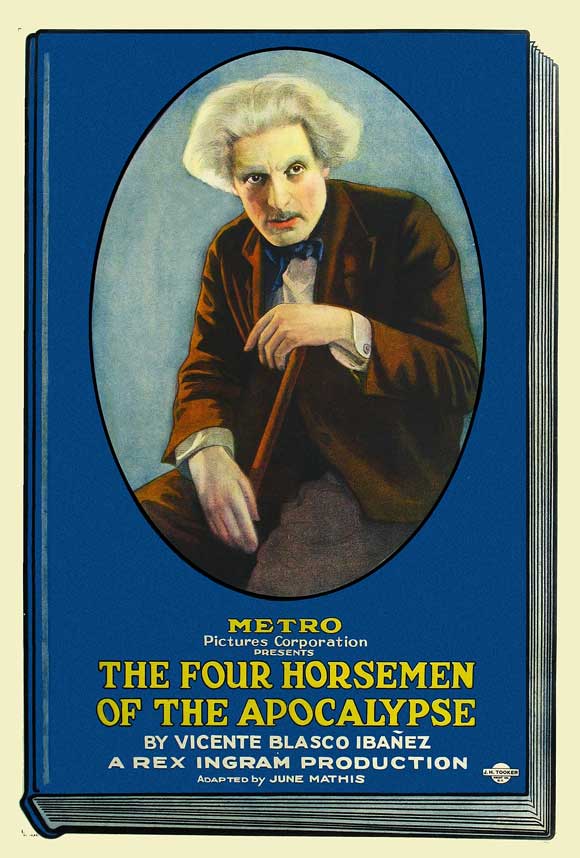“The Four Horsemen of the Apocalypse” is one of the most famous silent war movies. It was directed by Rex Ingram and was based on the novel by Spaniard Vincente Ibanez. June Mathis wrote the screenplay. She went on to become one of the first female executives in Hollywood. She was second in power only to Mary Pickford. She was the one that tabbed a little-known actor to play Julio. She wrote the tango scene just for him. Rudolf Valentino rocketed to superstardom because of the film. Mathis and Valentino became fast friends for the rest of her life. She wrote several screenplays for him. He was paid $350 per week for “Four Horsemen”, less than all the other important members of the cast. The film cost $800,000 and was the first film to make more than $1 million. It is the highest grossing silent film when you adjust for inflation. It was such a huge hit that it created crazes for tango dancing and gaucho pants. Valentino’s Julio became the model for “Latin lovers”. But does it hold up as a great movie?
The movie opens in Argentina before WWI. Madariaga (Pomeroy Cannon) is a ruthless cattle baron. He has two sons-in-law that vie for his affections. Karl (Alan Hale) is a German and Marcelo (Josef Swickard) is French. The family is dysfunctional. Madriaga is fond of Marcelo’s son Julio and it is clear Julio will come before Karl’s two sons when it comes to the inheritance. Madriaga teaches Julio to tango and accompanies the young rake on his trips to night clubs. Julio is a chip off the old block. When Madariaga dies, the inheritance is split between his two daughters. The family is also split as Karl’s go to live in Germany and Marcelo’s goes to France. Karl’s sons grow up to be disciplined exemplars of the German “super culture”. Julio is the opposite and exemplifies French culture. He is a painter – of women. Paris is crazy for the tango, so Julio is taking advantage of that. He is openly wooing a married woman. Suddenly, some archduke gets assassinated and this causes the opportunity to prove which culture is superior. War fever is in the air. Even Julio’s monkey catches it. A Rasputin-like mystic warns of the four horsemen using a Durer etching. Julio goes to war for France (with his monkey) and his German cousins join the German army. The last act has the war coming to Marcelo’s mansion. The army happens to include Karl’s boys. It won’t be a pleasant family reunion.
When I started this blog it was with the goal of compiling by own list of the 100 Best War Movies. I was inspired by Military History magazines 100 Greatest War Movies list and began by reviewing those movies. From the beginning I made the decision to rate movies based on how good they are, not how important they are or how great they were at the time they were released. Obviously, 21st Century war movies have advantages in technology and ability to realistically recreate combat. That does not mean that a war movie has to be modern to be good. War movies are still driven by plots and that levels the playing field.
The reason why “The Four Horsemen of the Apocalypse” is not a good movie is not because it is old, silent, and black and white. It’s not good because it is not entertaining. The plot is weak and heavy-handed. It has been called the “first anti-war film”, but it is not realistic in its depiction of war. This is partly because of the inability of movies back then to recreate combat. The way it conveys the horror of war is by showing two families torn apart by it. But it is hard to care about them. Julio is not likeable. Women weren’t attracted to his personality. He was the bad boy you imagined having an affair with. His character arc is not believable. He goes from rogue to warrior without us seeing the transformation. We are told he is a good soldier, but there’s no proof and it seems unlikely. In fact, Valentino is not on the screen for long stretches. He does show some acting chops and the rest of the cast manages to avoid the over the top mugging of most silent films. Only Swickford chews scenery.
There is no doubt the film is an important one. However, importance does not always equate to quality. I doubt many of my readers would find it entertaining if they have not seen it already. Plus, it’s a long movie and could be a chore to watch. Naturally, females might find it more appealing because of Valentino, but I’m pretty sure most women’s ideal man today does not wear gaucho pants. On the other hand, I do feel that if you are a war movie fanatic, like me, it is a must-see. If only to see how far war movies have come. Plus, guys can learn the smoldering look. Women still like that. And you could learn the tango. I’ve been told it takes two to do it.
GRADE = D+

_poster.jpg)
_poster.jpg)